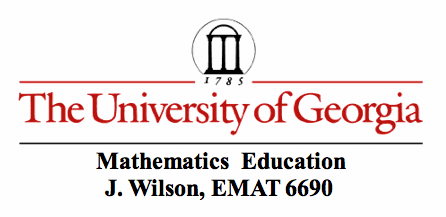

You are probably wondering "What is a Fermi Question?" Well Enrico Fermi developed the process for large number estimation problems. He would take a series of different approximations and use them to come up with a reasonable estimate for the answer. These problems often require a little research in order to get the information that you need in order to solve the problem or answer the question. For this essay, we are going to take a look at one interesting Fermi Question:
"Will all of the people in the world fit in one cubic mile?"
There are a few different things that we will need to know in order to decide if the answer to our question is yes or no. We will also be using this GSP file to show some illustrations. First of all, we need to know the volume of an average woman and an average man. This is hard to decide since average height among countries differs greatly, yet we are estimating and after some research you may come to a similar estimate that the average height of a woman is 5 feet 4 inches tall and the average height of a man is 5 feet 10 inches tall. Thus, we can think of how large a box would need to be in order to fit an average sized man and an average sized woman. For a woman the height would probably need to be 1.5 feet in length, 1 foot in width, and of course 5 feet 4 inches tall. For an average man, the height would probably need to be about the same so 1.5 feet in length, 1 foot in width, and of course 5 feet 10 inches tall. So now we have the two rectangular prisms below representing the volumes of an average woman and an average man in the world.
We now need to know the world population. With a little exploration on Google, it seems that the world population is 6,973, 738, 433 people. However, women make up 51% of the population while men make up 49% of the population. Thus, we find that their are approximately 3, 556, 606, 601 women and 3, 417, 131, 832 men. This means that we will need to fit 3, 556, 606, 601 boxes representing the volume of the women and 3, 417, 131, 832 boxes representing the volume of the men. Those boxes have to fit within a cubic mile. We represent the cubic mile by using a cube with sides of length 5,280 feet. That cubic mile would look like the box below.
Both of these representations have been put on the GSP file. In order to see if all of the people will fit, we need to know how much volume all of the people take up. We can first calculate the volume of all of the women. One woman would have a volume of
. We can then multiply that volume by the number of women in the world to get the total volume for all women. We get
. Now we need to do the same for the men. For one man we get
. Then for all men we get
. Now we need to know the dimensions of a box for those two volumes.
One might find that we can take the cube root of each volume in order to get the length of a side of a cube which has that volume. So for our cube for the women's volume we will have a side length of 3052.24 feet. and for the men's volume we will have a side length of 3088.93 feet. We can now make GSP representations of these two cubes (page 3 of GSP file).
Let's now see if we can fit just women into the cubic mile (page 4). We see that we have quite a bit of space left in the cubic mile. How much exactly do we have left? Well the total volume of a cubic mile would be
. So the volume that we have left is
.
Now we need to know the length the side of a cube which will represent the remaining volume. By finding the cube root of the left over volume we find that the side length would be 4915.416 ft. We will now make a cube with this side length and see if the volume of all the men will fit inside (page 5 GSP file).
Once again, we notice that we have a lot of volume still left. We have
left. This shows that we can not only fit the entire world population within a cubic mile but we could actually fit more than double the entire world population in one cubic mile!
As we see after some research and problem solving, we were able to come to an answer to our Fermi Question!
Return